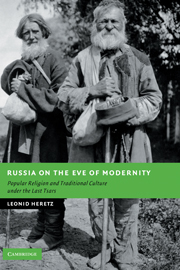Book contents
- Frontmatter
- Contents
- Acknowledgments
- Introduction
- 1 The traditional worldview
- 2 The Old Believers: modernization as apocalypse
- 3 The sectarians: dualism and secret history
- 4 Folk eschatology
- 5 The assassination of Alexander II (1881) and folk Tsarism
- 6 The year of famine and cholera (1891–1892): demonization of the nobility
- 7 The Japanese War: peasant Russia and the wider world
- 8 1905: revolution or reaction?
- 9 The Great War and the crisis of the traditional culture
- Epilogue
- Bibliography
- Index
- NEW STUDIES IN EUROPEAN HISTORY
1 - The traditional worldview
Published online by Cambridge University Press: 23 December 2009
- Frontmatter
- Contents
- Acknowledgments
- Introduction
- 1 The traditional worldview
- 2 The Old Believers: modernization as apocalypse
- 3 The sectarians: dualism and secret history
- 4 Folk eschatology
- 5 The assassination of Alexander II (1881) and folk Tsarism
- 6 The year of famine and cholera (1891–1892): demonization of the nobility
- 7 The Japanese War: peasant Russia and the wider world
- 8 1905: revolution or reaction?
- 9 The Great War and the crisis of the traditional culture
- Epilogue
- Bibliography
- Index
- NEW STUDIES IN EUROPEAN HISTORY
Summary
At the beginning of the twentieth century, the great majority of Russians lived within an integral, traditional, religious culture which directed all aspects of life and action and which infused the world and events with meaning. The following pages will sketch the outlines of the traditional Russian worldview, paying particular attention to the traditional understanding of causality. This examination will, in turn, provide the key for making sense of peasant interpretations of specific historical events of the last decades of the Russian Empire.
SOURCES
The reader might assume that the ideas and beliefs of the traditional Russian peasantry are beyond the reach of the historian because of a dearth of documentation. It is certainly true that details (e.g. folk responses to specific events) are very elusive, but there is in fact a great abundance of information on Russian peasant culture, particularly for the late Imperial period. Most notably, there is the immense body of material collected by Russian ethnographers in the latter part of the nineteenth century and at the beginning of the twentieth. Although numerous valuable works on folk beliefs have appeared in monograph form, the great bulk of information remains in the condition of raw, primary material to be found in periodicals. The scholarly ethnographic journals of the period offer an extensive (although far from complete) picture of peasant life and belief, and much relevant information can be found in general academic publications, as well as in official organs of the state and church.
- Type
- Chapter
- Information
- Russia on the Eve of ModernityPopular Religion and Traditional Culture under the Last Tsars, pp. 14 - 41Publisher: Cambridge University PressPrint publication year: 2008

